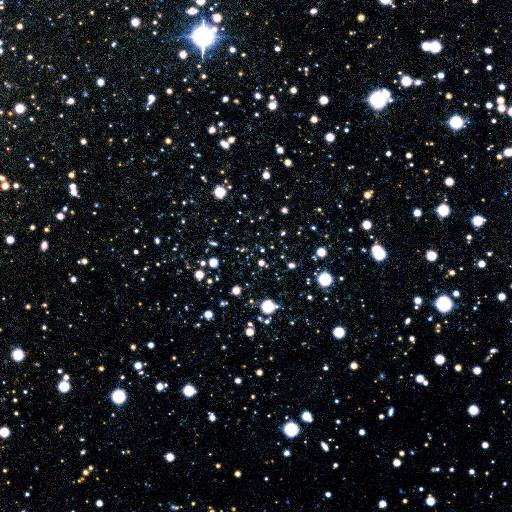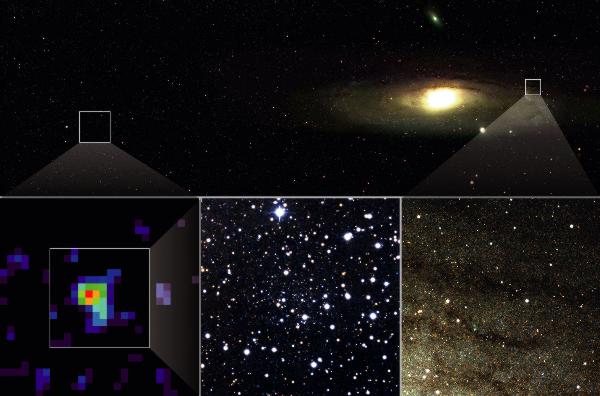
| SDSS Classic |
| SDSS.org |
| SDSS4.org |
| SDSS3.org |
| SDSS Data |
| DR19 |
| DR17 |
| DR10 |
| DR7 |
| Science |
| Press Releases |
| Education |
| Image Gallery |
| Legacy Survey |
| SEGUE |
| Supernova Survey |
| Collaboration |
| Publications |
| Contact Us |
| Search |

Andromeda 9 -- The Faintest Galaxy Ever
Sloan Digital Sky Survey Discovers the Lowest Luminosity Galaxy Yet: Andromeda IX, a New Satellite of M31
CONTACTS:Daniel Zucker, Max Planck Institute for Astronomy, Heidelberg, Germany, zucker@mpia.de
Eric Bell, Max Planck Institute for Astronomy, bell@mpia.de
Michael A. Strauss, SDSS Scientific Spokesperson, (609) 258-3808, strauss@astro.princeton.edu
IMPORTANT NOTE: On May 31 and June 1, Zucker and Bell will be attending the AMERICAN ASTRONOMICAL SOCIETY meeting in Denver and can be reached immediately following their panel presentation through the AAS Press Room at 303 228-8370 (three lines); FAX 303 228-8373
DENVER (May 31, 2004) -- A team of astronomers from the Sloan Digital Sky Survey (SDSS) collaboration has discovered the faintest galaxy yet -- right in our cosmic backyard.
The new galaxy, named Andromeda IX for its location near M31, the Andromeda galaxy, is nearly twice as faint as the previous record holder, and is so diffuse that it appears 100 times dimmer than the night sky.

|
This figure shows Andromeda IX, the least luminous galaxy yet discovered. Most of the stars in this image are foreground stars from the Milky Way; Andromeda IX is barely visible as the slight concentration of faint stars
in the center of the image. Andromeda IX is some 100,000 times fainter than M31 (also called the Andromeda Galaxy) or the Milky Way, has a diameter of roughly 3,000 light years, and lies at a distance of 2 million light years from the Sun.
CREDIT: Daniel Zucker; The Sloan Digital Sky Survey. Imaging data for the lower center panel was taken from
from Isaac Newton Groups' Wide Field Camera Survey (www.ing.iac.es), Nial Tanvir.)
(Click on image to enlarge) |
"Traditional galaxy searches are not sensitive enough to detect such objects, so instead we looked for clumpings of faint stars and found this incredibly dim galaxy right next to M31," explains Zucker. M31, at a distance of 2 million light years, is the closest large galaxy to our own Milky Way galaxy, and is barely visible to the naked eye from the northern hemisphere during the autumn months.

|
(Top): This figure shows part of the SDSS scan of M31 (also called the Andromeda Galaxy) and Andromeda IX. (Lower Left): This panel shows the relative density of faint stars in a small region of the scan highlighted above; the bright, high-density clump of stars in the center reveals the location of Andromeda IX. (Lower Center): This panel shows a zoomed-in image of Andromeda IX, barely visible as the slight concentration of stars in the center of the panel. Most of the bright stars are in fact foreground stars from the Milky Way, and are unrelated to Andromeda IX. Traditional search techniques would have difficulty in detecting Andromeda IX directly. (Lower right): A section of the outer disk of M31, covering the same area as the Andromeda IX inset. Andromeda IX is clearly much smaller and fainter than M31. CREDIT: Daniel Zucker; The Sloan Digital Sky Survey. Imaging data for the lower center panel was taken from from Isaac Newton Groups' Wide Field Camera Survey (www.ing.iac.es), Nial Tanvir. (Click on image to enlarge) |
The SDSS telescope is unique in its ability to discover extremely dim galaxies like the one announced today. Rather than studying a point in the sky, the 2.5-meter optical telescope scans a horizon-to-horizon swath each night. Its camera uses charged coupled devices (CCDs) -- ultra-sensitive versions of the electronic detectors found in digital cameras -- which turn light into digital signals in five different wavelengths.
"SDSS is able to find really quite faint objects," explains Bell. "The mapping is incredibly efficient -- typically by a factor of 10 to 100 faster than other telescopes. It is mapping very faint objects over an enormous area on the sky, allowing very rare classes of galaxies to be discovered. Since Andromeda IX is both rare and faint, the SDSS telescope and camera were excellent tools for finding it."
Once they had discovered Andromeda IX, the researchers used both the SDSS data and older archival images to investigate its properties. While Andromeda IX has many of the characteristics of a dwarf spheroidal galaxy -- a class of small, relatively faint, oval-shaped galaxies typically found as satellites of larger galaxies -- it is significantly fainter and more diffuse than any found to date.
The Ursa Minor dwarf spheroidal galaxy, a satellite of the Milky Way, was previously considered to be the faintest galaxy known, but with a total luminosity of some 200,000 Suns, Andromeda IX is about two times fainter than Ursa Minor and 100,000 times fainter than the Milky Way. What's more, the relatively few stars in Andromeda IX are spread over a region with a diameter of about 3,000 light years, which makes Andromeda IX also the most diffuse galaxy known.
But the discovery of Andromeda IX is not just interesting for setting a record. It may also point the way to solving a major mystery in modern astronomy -- the "missing satellites" problem.
The leading theoretical models for how large structures -- galaxies and clusters of galaxies -- formed in the Universe employ a concept called dark matter. Dark matter can only be detected via its gravitational pull, neither emitting nor reflecting light (hence the "dark" in its name).
The models hold that this dark matter began clumping together soon after the Big Bang, while the normal matter was still too hot to come together. Smaller clumps of dark matter merged to form larger and larger clumps, and when the normal visible matter had cooled sufficiently to "feel" the gravitational pull of the dark matter, it collapsed onto these dark matter clumps. In this way, the dark matter clumps acted as seeds for galaxy formation.
The problem is that the models also predict large galaxies should have something like 100 times more small galaxy companions, each associated with a clump of dark matter, than have been seen to date. The discovery of Andromeda IX raises the possibility these galaxies could simply be too faint and diffuse to have been detected in previous surveys.
"The wide area coverage and excellent sensitivity of the SDSS data are truly unprecedented, and have enabled us to find incredibly faint objects like Andromeda IX and Andromeda NE from their component stars, rather than by their total light," notes SDSS discovery collaborator Eva Grebel of the University of Basel, Switzerland. (Andromeda NE can be seen at www.sdss.org/news/releases/20040105.andromeda.php )
Using the same analysis techniques, the astronomers have found a number of additional clumps of objects. "These are possibly clusters of distant galaxies; yet if even a few of these turn out to be nearby faint galaxies, they could go a long way toward solving the missing satellites problem," adds Alexei Kniazev, of the Max Planck Institute. "We need more data to be sure."
In addition to SDSS scientists at the Max Planck Institute and the Astronomical Institute of the University of Basel, the international group discovering Andromeda IX includes SDSS collaborators from the University of Washington, Seattle, and New Mexico State University in Las Cruces.
AUTHORS OF THE PAPER ARE:
Daniel Zucker, Max Planck Institute for Astronomy, Koenigstuhl 17, 69117 Heidelberg, Germany, zucker@mpia.de
Alexei Kniazev, Max Planck Institute for Astronomy, kniazev@mpia.de
Eric Bell, Max Planck Institute for Astronomy, bell@mpia.de
David Martinez-Delgado, Max Planck Institute for Astronomy, ddelgado@mpia.de
Eva Grebel, Astronomical Institute, University of Basel, Venusstrasse 7,4102 Binningen, Switzerland, grebel@astro.unibas.ch
Hans-Walter Rix, Max Planck Institute for Astronomy, rix@mpia.de
Constance Rockosi, Astronomy Department, University of Washington, Box 351580, Seattle WA 98195-1580, cmr@astro.washington.edu
Jon Holtzman, Department of Astronomy, New Mexico State University,1320 Frenger Mall, Las Cruces NM 88003-8001, holtz@nmsu.edu
Rene Walterbos, Department of Astronomy, New Mexico State University,rwalterb@nmsu.edu
James Annis, Fermi National Accelerator Laboratory, P.O. Box 500, Batavia,IL 60510, annis@fnal.gov
Donald York, Department of Astronomy and Astrophysics, University of Chicago, 5640 South Ellis Avenue, Chicago, IL 60637,don@oddjob.uchicago.edu
Zeljko Ivezic, Princeton University Observatory Princeton, NJ 08544,ivezic@astro.princeton.edu
J. Brinkmann, Apache Point Observatory, P.O. Box 59, Sunspot, NM88349, jb@apo.nmsu.edu
Howard Brewington, Apache Point Observatory, hbrewington@apo.nmsu.edu
Michael Harvanek, Apache Point Observatory, harvanek@apo.nmsu.edu
Greg Hennessy, US Naval Observatory, 3450 Massachusetts Avenue, NW, Washington, DC 20392-5420, gsh@usno.navy.mil
S. J. Kleinman, Apache Point Observatory, sjnk@apo.nmsu.edu
Jurek Krzesinski, Apache Point Observatory, jurek@apo.nmsu.edu
Dan Long, Apache Point Observatory, long@apo.nmsu.edu
Peter Newman, Apache Point Observatory, prn@apo.nmsu.edu
Atsuko Nitta, Apache Point Observatory, ank@apo.nmsu.edu
Stephanie A. Snedden, Apache Point Observatory, snedden@apo.nmsu.edu